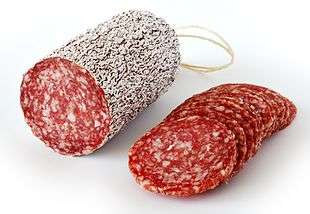Bratwurst
Bratwurst (German: [ˈbʁaːtvʊɐ̯st] (![]()
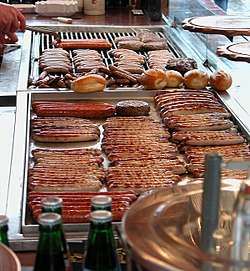 A variety of Bratwürste on a stand at the Hauptmarkt in Nuremberg | |
| Type | Sausage |
|---|---|
| Course | Main |
| Place of origin | Germany |
| Region or state | Europe |
| Main ingredients | Meat (veal, pork or beef) |
History
While sausage recipes can be found as early as 228 AD, the first documented evidence of the Bratwurst in Germany dates to 1313 and can be found in the Franconian city of Nuremberg,[2][3] which is still an internationally renowned center for the production of grilling sausages.
Types and traditions
Germany
Recipes for the sausage vary by region and even locality; some sources list over 40 different varieties of German bratwurst,[4][5] many of the best known originating in Franconia (today for the most part situated in northern Bavaria, but still culturally quite distinct), its northern neighbour Thuringia and adjacent areas. How the sausages are served is also locally different, but most commonly they are regarded as a snack served with or in a white bread roll made from wheat flour and eaten with mustard. As a pub dish, it is often accompanied by sauerkraut or potato salad and sometimes served with dark, crusty country bread made predominantly from rye flour, less commonly with a Brezel (pretzel). It is a very popular form of fast food in German-speaking countries, often cooked and sold by street vendors from small stands.
Franconian varieties
Fränkische Bratwurst
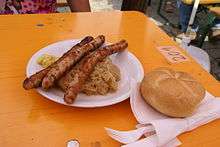
The Franconian sausage is a relatively long (10–20 cm [4–8 in]), thick, coarse sausage, common to the whole Franconian region with slight variations. It dates back to 1313. With marjoram as a characteristic ingredient, it is close in taste to the Nürnberger Bratwurst but juicier, due to its size and coarseness. The Fränkische Bratwurst is traditionally served with sauerkraut or potato salad.
Coburger Bratwurst
Bratwurst originating in the city of Coburg in Franconia was first documented there in 1498.[6] It is made from pork and a minimum of 15% beef, seasoned with only salt, pepper, nutmeg, and lemon zest, and bound with raw egg.[7] It is coarse in texture and is about 25 cm (10 in) long. Traditionally, it is grilled over pinecones and served in a bread roll (Brötchen).
Kulmbacher Bratwurst
The Kulmbacher Bratwurst is a finely-ground Rohwurst from the city of Kulmbach in Upper Franconia. Long and thin, it is made mostly from very finely ground veal, with very little pork. This sausage may be seasoned with salt, white pepper, nutmeg, lemon peel, marjoram, caraway, and garlic. The exact mixture is a closely guarded trade secret of each butcher. Kulmbacher bratwursts are usually pan-fried, or grilled over a wood fire. They are sold and served freshly grilled from vendors' stands in the Marktplatz, in pairs, with or without mustard, on crusty rolls sprinkled with anise.
Nürnberger Rostbratwurst
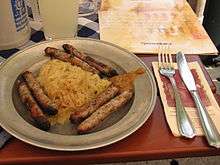
The small, thin bratwurst from Franconia's largest city, Nuremberg, was first documented in 1567; it is 7 to 9 cm (2.8 to 3.5 in) long, and weighs between 20 and 25 g. The denominations Nürnberger Bratwurst and Nürnberger Rostbratwurst (Rost comes from the grill above the cooking fire) are Protected Geographical Indications (PGI) under EU law since 2003,[8] and may therefore only be produced in the city of Nürnberg, where an "Association for the Protection of Nürnberger Bratwürste" was established in 1997.[9]
Pork-based and typically seasoned with fresh marjoram which gives them their distinctive flavour, these sausages are traditionally grilled over a beechwood fire. As a main dish three to six pairs are served on a pewter plate with either sauerkraut or potato salad, and accompanied by a dollop of horseradish or mustard. They are also sold as a snack by street vendors as Drei im Weckla (three in a bun; the spelling Drei im Weggla is also common, Weggla/Weckla being the word for "bread roll" in the Nuremberg dialect), with mustard.
Another way of cooking Nuremberg sausages is in a spiced vinegar and onion stock; this is called Blaue Zipfel (blue lobes).
- Nürnberger Rostbratwurst
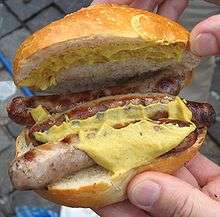 Drei im Weggla
Drei im Weggla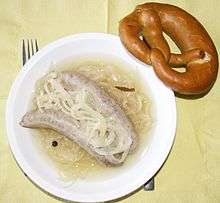 Blaue Zipfel mit Brezel
Blaue Zipfel mit Brezel
Würzburger Bratwurst
The Würzburger Bratwurst, also known as the Winzerbratwurst, comes from the city of Würzburg in Franconia. Its size is similar to the Thüringer Rostbratwurst, but its ingredients include white Franken-Wine.
Other varieties
Thüringer Rostbratwurst
The Thüringer Rostbratwurst is a spicy sausage from Thuringia. It is thin and 15–20 cm (6–8 in) long. It is traditionally grilled over a charcoal fire and eaten with mustard and bread. The name Thüringer Rostbratwurst is also recognised as a PGI under EU law.
Triggered by the discovery in 2000 of an account entry of 1404 first mentioning the Bratwurst in Thuringia in the town of Arnstadt, the association "Friends of the Thuringian Bratwurst" was founded in 2006. In the same year, the association established the Erstes Deutsches Bratwurstmuseum (First German Bratwurst Museum) in the village of Holzhausen. A two-metre-high wooden monument of a Bratwurst in a bun on a local traffic roundabout advertises the museum.[10]
 Thüringer Rostbratwurst in a bun with mustard
Thüringer Rostbratwurst in a bun with mustard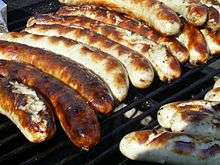 Close-up of Thüringer Rostbratwurst
Close-up of Thüringer Rostbratwurst
Nordhessische Bratwurst
The 20 cm (8 in)-long Nordhessische Bratwurst (from northern Hessen) is similar to the Thüringer Rostbratwurst in taste. It is made from coarsely ground pork and is heavily seasoned. Traditionally, it is grilled over a wood fire and served on a cut-open roll with mustard.
Rote Wurst
The Rote Wurst (red sausage) is a favorite Bratwurst of the Swabian region. It is similar to the Bockwurst, and is made from finely ground pork and bacon, and has a spicy taste. To prevent splitting during grilling or pan frying, an X is cut into the ends of the sausage, which opens during cooking. Sometimes a row of x-shaped cuts are made along its length.
Switzerland
In 1438, bratwurst started to become popular in eastern Switzerland, especially in St. Gallen. "St. Galler bratwurst" has been famous since then. You can find shops which sell St. Galler bratwurst with a round bread (Swiss German: bürli) on the street, also served in the restaurant with hash browns (Swiss German: rösti).[11]
United States
Bratwurst, often shortened to "brat" in American English, is a common type of sausage in the United States, especially in the Upper Midwestern region; the home to many people of German-American ethnicity. Wisconsin, where the largest ancestry group is German, is known for its bratwursts. Brats are also popular in other Upper Midwestern states such as Minnesota, Missouri, Ohio and Iowa, as well as cities with large populations like New York, Chicago, and Philadelphia. [12] Originally brought to North America by German immigrants, it is a common sight at summer cookouts, along with hot dogs. Many grocery stores and butcher shops sell varieties with popular additions such as cheddar cheese and jalapeño peppers. Wisconsin is the home of the "beer brat", where the brats are simmered in beer (generally a mixture of a pilsner style beer with butter and onions) before or after grilling over charcoal.[13]
Bratwurst was popularized in Sheboygan County, Wisconsin, in the 1920s. In general, each local butcher shop would take orders and hand make bratwurst fresh to be picked up on a particular day. The fat content of the sausages was substantial, making daily pick up necessary to avoid spoilage; some of the fat is lost on cooking over charcoal.[14]
Bratwurst has also become popular as a mainstay of sports stadiums, especially baseball parks, after Bill Sperling introduced bratwurst to Major League Baseball in Milwaukee County Stadium in 1954, when the Boston Braves moved to Milwaukee. The brats, which sold for 35 cents, were grilled and placed into a container of a special tomato sauce with green pepper and onions before being served.[15] The bratwursts were so popular, Sperling said, that Duke Snider of the Brooklyn Dodgers took a case back to New York City.[16] Miller Park in Milwaukee sells more bratwurst than hot dogs.[17] Current Miller Park foodservice provider Delaware North (through their Sportservice subsidiary) markets Secret Stadium Sauce at retail as a complement to bratwurst.
Every year, during the Memorial Day weekend, the city of Madison, Wisconsin, hosts the Brat Fest, which is billed as the "world's largest bratwurst festival".
The town of Bucyrus, Ohio, (which calls itself the "Bratwurst Capital of America") has held the three-day Bucyrus Bratwurst Festival annually since 1967.[18][19]
See also
References
- "LEO Deutsch-Englisch Wörterbuch". Retrieved 2009-04-09.
- Tjiang, Thomas (2013-09-13). "Nürnberger Bratwurst-Klassiker wird 700 Jahre alt". Welt Online. Retrieved 2016-09-04.
- "Geschichte der Bratwurst: Neue historische Quelle ruft Streit zwischen Thüringern und Franken hervor". Retrieved 2016-09-04.
- German Food Guide
- Whitlock, Craig (2007-12-02). "Germans Take Pride in the Wurst". The Washington Post.
- 1. Deutsches Bratwurstmuseum — History of the Bratwurst
- "Coburger Bratwurst". German Food Guide & Directory. Retrieved 7 April 2018.
- "Commission of the European Commission Regulation (EC) No 1257/2003". Retrieved 2009-04-18.
- Schutzverband Nürnberger Bratwürste e.V.
- "Geschichte der Bratwurst - Bratwurstmuseum Holzhausen / Verein "Freunde der Thüringer Bratwurst e.V."". www.bratwurstmuseum.de. Retrieved 2016-09-04.
- Kussin, Zachary (November 14, 2016). "Eat your way through Switzerland's sausage capital". New York Post. Retrieved May 23, 2018.
- ""Ancestry: 2000," U.S. Census Bureau" (PDF). Archived from the original (PDF) on 2004-09-20. Retrieved 2007-06-13.
- Ari Lavaux "A Debate of Grilling Bratwurst", Memphis Flyer, July 17, 2014. Retrieved May 10, 2019.
- R. W. Apple, Jr. "The Meat That Made Sheboygan Famous", The New York Times, June 5, 2002. Retrieved July 14, 2014.
- Buz Swerkstrom. "County Stadium's wurst move". Milwaukee Sentinel, June 1, 1988, part 3, pp. 1,3.
- madison.com
- "At Miller Park, more sausages than hot dogs are sold". Archived from the original on 2013-10-04. Retrieved 2013-02-27.
- Fenton, Laura (August 19, 2005). "What!? I can get this stuff for how much?". Today at msnbc. Retrieved 2009-10-28.
- "Discover Ohio". Ohio Department of Development, Division of Tourism. Archived from the original on 2007-01-16. Retrieved 2011-02-12.

